Children's Games (Bruegel) facts for kids
Quick facts for kids Children's Games |
|
|---|---|

Pieter Bruegel the Elder, Children’s Games
|
|
| Artist | Pieter Bruegel the Elder |
| Year | 1560 |
| Type | Oil on panel |
| Dimensions | 118 cm × 161 cm (46 in × 63 in) |
| Location | Kunsthistorisches Museum, Vienna |
Children's Games is a famous painting by the Flemish artist Pieter Bruegel the Elder. He painted it in 1560 using oil on a wooden panel. This amazing artwork is now kept at the Kunsthistorisches Museum in Vienna, Austria.
What the Painting Shows
This painting was first mentioned in a book in 1604. It was bought by Archduke Ernest of Austria in 1594. Some people think it was meant to be the first in a series of paintings about the different stages of life, with Children's Games showing Youth. But it seems Bruegel didn't paint any more in this series.
The painting is packed with children of all ages, from toddlers to teenagers. They are busy playing all sorts of games! You can see them rolling hoops, walking on stilts, spinning tops, riding toy horses, and even having pretend tournaments. They play leapfrog, blind man's buff, and do handstands. Some are blowing up pig bladders to make balloons, while others play with dolls and other toys.
The children have even taken over the big building in the town square. It might be a town hall or another important building. This shows that even adults, who run important city affairs, can be seen as children in the eyes of God. Even the landscape in the top left corner is full of kids swimming and playing by the river.
Bruegel's goal with this painting was more than just showing a list of games. He wanted to show how serious children are when they play. They are just as focused as adults are in their "important" jobs. The message is that to God, children's games are just as meaningful as what adults do. This idea was common in books and poems from that time. One old poem from 1530 compared people to children who are totally focused on their silly games and worries.
The Games in the Painting
About 80 different games have been found in the painting! Here are some of them, starting from the bottom left:
| Number | Image | Game | Notes |
|---|---|---|---|
| 01 | 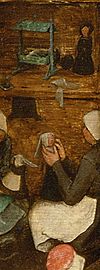 |
Playing with dolls | |
| 02 |  |
Playing 'Holy Mass' | Using small church objects for play. |
| 03 |  |
Water gun and owl on support | Shooting water at a bird. |
| 04 |  |
Wearing masks | Dressing up for fun. |
| 05 | 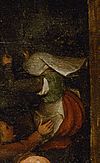 |
Swing | The classic hanging seat. |
| 06 |  |
Climbing a fence | A popular activity, especially with neighbor's fences! |
| 07 | 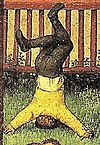 |
Handstand | All about balance! |
| 08 | 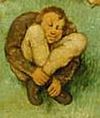 |
Play the "knot" | Bending your body into twisted shapes. |
| 09 | 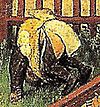 |
Somersault | Flipping and rolling forwards, backwards, or sideways. |
| 10 |  |
Fence riding | Another game involving fences. |
| 11 |  |
Mock wedding | Pretending to have a wedding. Mock child weddings were common folk traditions. |
| 12 |  |
Passing through kicking legs - running the gauntlet | A bit painful but exciting! |
| 13 |  |
Blind Man's Bluff | A classic game where one person is blindfolded. |
| 14 |  |
Playing with birds | Always popular. |
| 14b | 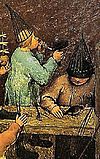 |
Making hats with twigs | Like weaving baskets. |
| 15 | 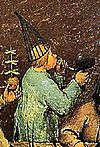 |
Soap bubbles | Bruegel shows children blowing bubbles with clay pipes, proving this fun has been around for at least 400 years! |
| 16 | 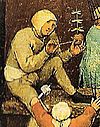 |
Shell bobbin | A flying spinner made from nut shells. |
| 17 | 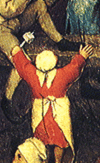 |
The "Toton" | An early version of roulette and dice games. |
| 17b | 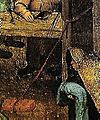 |
Toy animal with leash | Looks like a stone dog. |
| 18 |  |
Knucklebones | A very old game played with five small objects, originally sheep ankle bones. |
| 19 |  |
Mock baptismal | Acting out adults bringing a baby home after a baptism. |
| 20 |  |
Morra | A hand game, similar to rock, paper, scissors, dating back thousands of years. |
| 21 |  |
Piñata | A decorated container filled with toys or candy, broken during celebrations. |
| 22 | 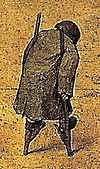 |
Walk on stilts | Walking on poles with footrests, these are short. |
| 23 |  |
Play leapfrog | Jumping over each other's bent backs. |
| 24 | Mock tournaments | Pretend competitions of different kinds. | |
| 25 |  |
The "Pope's seat" | Holding a child by gripping hands. |
| 26 |  |
Hobby-horse | Riding a wooden stick with a horse's head. |
| 27 | 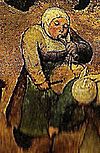 |
Playing the flute and the drum | Making simple music with basic instruments. |
| 28 | 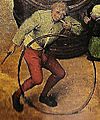 |
The simple roll hoop | Children and adults worldwide have played with hoops for centuries. |
| 29 |  |
Shouting into a barrel from a hole | Finding many uses for a barrel. |
| 30 |  |
The hoop with bells | A different way to roll a hoop. |
| 31 | 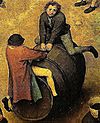 |
Riding the barrel | Another popular game with barrels. |
| 32 |  |
Hat throwing | Throwing hats through open legs or seeing who can throw farthest. |
| 33 |  |
Raisinbread man | A bread loaf shaped like a man, perhaps a Dutch duivekater. |
| 34 |  |
The penalty of "bumbouncing" | Bouncing someone's bottom on planks. |
| 35 |  |
Ball made with an inflated pig's bladder | Inflating a pig's bladder to make a balloon. |
| 36 | 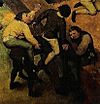 |
Buck buck | A group of children make a "pony" and others leap on their backs until it collapses. |
| 37 | 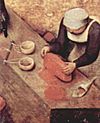 |
To play shop | Bruegel signed and dated the painting on a wooden plank here. |
| 38 |  |
Playing Tiddlywinks | Using small discs ("winks") and a "squidger" to flick winks into a pot. |
| 39 |  |
Playing Mumblety-peg | An old outdoor game using pocketknives. |
| 40 | Building (a well) | Like building sandcastles, always popular. | |
| 41 |  |
Pulling hair | Is it a game or a fight? |
| 42 |  |
Catching insects with a net | Not just butterflies! |
| 43 |  |
Playing the scourge | Not a very safe game. |
| 44 |  |
Playing marbles | Ancient and still popular today. |
| 45 |  |
Pitch and toss | Players toss coins towards a wall; the closest coin wins. |
| 45b | 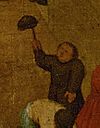 |
Twirling a hat on a stick | Something clowns often do. |
| 46 | 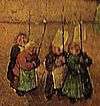 |
Making a procession | Popular with both children and adults. |
| 47 | 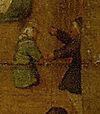 |
Playing the porter | Or maybe a goalkeeper? |
| 48 |  |
Who's got the ball? | Hiding the ball and guessing who has it. |
| 49 | 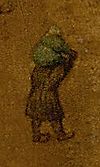 |
Riding piggyback | Still a fun way to get around! |
| 50 |  |
Singing door-to-door | Especially around Christmas with carols. |
| 51 |  |
Bonfire | Lighting a fire, a dangerous but common activity. |
| 52 |  |
Riding a broom | A variation of hobby-horse, but with many players. |
| 53 |  |
Pushing a wall | Good for exercising muscles. |
| 54 |  |
Hide-and-seek | A game where players hide and one or more seekers try to find them. |
| 55 | The "devil's tail" or the "snake" | A role-play street game. | |
| 56 |  |
Grappling | A basic form of wrestling. |
| 57 |  |
The "devil chained" | Another role-play street game. |
| 58 | 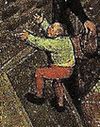 |
Run, jump on a cellar's door | Noisy and a bit unsafe! |
| 59 |  |
Bowling | Players roll a ball to hit pins or get close to a target ball. |
| 60 |  |
The token | Running and passing a baton to the next runner. |
| 61 |  |
Throwing walnuts | Perhaps a version of bowling or bocce, hitting a group of nuts. |
| 62 | 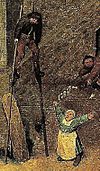 |
High stilts | Walking on very long poles. |
| 63 |  |
Pole vaulting | Exercising on a horizontal bar. |
| 64 | 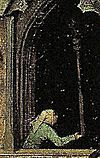 |
Balancing a stick on a finger | A fun balance game, like a clown would do. |
| 65 |  |
Put up a show | Acting out a play. |
| 66 |  |
Spinning tops | Using toys that spin on a point. |
| 67 | 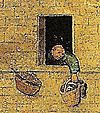 |
The trolleys | Baskets moving on a line. |
| 68 |  |
Flying a ribbon on a stick | Letting a piece of cloth fly in the wind from a stick. |
| 69 |  |
Whom shall I choose? | A girl picks her "baby" from friends under a blanket. |
| 70 |  |
Bocce | Teams throw balls to get closest to a smaller target ball. |
| 71 |  |
Pirouetting skirts | Girls swirling their skirts around and around. |
| 72 |  |
Climbing a tree | |
| 73 |  |
Swimming | A healthy and fun exercise. |
| 74 |  |
Diving | Jumping or falling into water is always fun! |
| 75 |  |
Floating with an inflated pig's bladder | Using a bladder to float or play water games. |
| 76 | 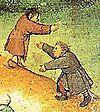 |
"Dethroning the King" | A role-play game. |
| 77 |  |
Playing with sand | Building castles and digging holes. |
| 78 | Coil tournament | A pretend fight between knights. | |
| 79 |  |
Rattles | A noisy musical game. |
See also
 In Spanish: Juegos de niños (Brueghel) para niños
In Spanish: Juegos de niños (Brueghel) para niños

